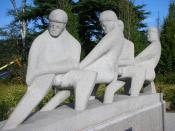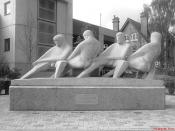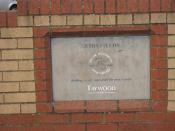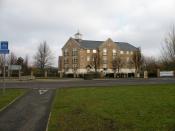Contents 1 ? Introduction 2 ? An overview 3 ? The strategic review 4 ? Eliminate non-core activities 5 ? Commitment to international developer 6 ? Culture changes 7 ? Gain strength and value 8 ? Planning elements ? a conclusion 1 - Introduction This report is concerned with Taylor Woodrow Plc. Taylor Woodrow is an international leader in housing, property and value added construction support.
I will try to establish what I believe to have been the key planning elements of Taylor Woodrow based on my interpretation of the annual report. I will ensure that I provide sufficient evidence upon which I have formulated my views.
Wider research will enable me to have more extensive evidence on which I will establish the planning elements.
The New Taylor Woodrow ? The International Developer 2 - An Overview Taylor Woodrow is an international leader with core businesses in housing and property.
In addition they also have a construction and engineering activity.
The organisation is in business to satisfy the needs of their clients. Their long-term success is dependent upon exceeding their expectations. They accomplish this through commitment to excellence and innovation and the delivery at all times of value-added products and services.
Taylor Woodrow is built on the core value of commitment, knowledge and trust: commitment to their customers, employees and shareholders; knowledge of their business and their markets; and trust with their clients, employees and business partners.
In 1999 the group produced pre-tax profits of ã125 million. These results justify the actions taken by the management team to position the business to meet market opportunities which the company is now well equipped to exploit. This obvious strength affords them wide flexibility and enables them to take the organisation forward.
3 - The Strategic Review A major strategic review was initiated in 1999. The review took place to identify how best to realise the value in Taylor Woodrow. The following statements outline where value lies or could lie: 1. Core activities, worldwide housing and property will continue their very profitable growth.
2. The construction business has a strong future as a focused provider of value added construction support.
3. There is a need to establish a leadership position in the growing market for mixed-use developments, which will unite property, housing and construction expertise.
4. Non-core activities should be disposed of.
The review can be seen as a vision for Taylor Woodrow and to make use of the review, objectives to meet this strategic planning have to be enforced. In line with the strategic review a number of key planning aims and objectives can be found. These are highlighted below: 4 ? Eliminate non-core activities In July 2000 Taylor Woodrow announced that Greenham Trading had been sold to Bunzl plc for ã76.4 million. Greenham reported lower operating profits in the first half of 2000 at ã2.3 million compared with ã3.4 million for the equivalent period of 1999. Turnover was up 1% at 71.7 million. Greenham Trading was sold, as it was not seen as a core activity as profit before tax decreased from ã8.7 million in 1998 to ã6.9 million in 1999. This was a result of static turnover as the business suffered from price deflation and a lack of major public works in the UK.
As construction only accounts for 13% of total profit, something had to be done to increase value. It was noted in the strategic review that there was a need for a leadership position in the market for mixed-use developments.
Taylor Woodrow has recognised that construction does have a future but in a reduced, more focused form. To help do this construction will increasingly work with housing and property, to exploit opportunities in mixed use and Brownfield developments. The Brownfield is a site development and it will require considerable engineering expertise. Few other companies other than Taylor Woodrow can provide the full range of skills required. Taylor Woodrow is extremely well placed to be a major participant in meeting these targets.
5 - Commitment to International Development The new corporate identity features the strapline ?The International Developer? to reflect the increasing role of international development in Taylor Woodrow?s portfolio. In 1999 54% of revenues were derived from international development, with 45% earned through house building in North America.
There has been a significant international spread of Taylor Woodrow?s activities. Just under half of their operating profits are derived from overseas. This provides some protection against a downturn in any one market. For instance activities in Toronto, Canada and Spain remain robust. This is a factor that is unique to Taylor Woodrow plc. The extensive international housing activities reduce significantly their exposure to uncertainties associated with the UK market and its challenging planning process. Taywood Homes is therefore focused on improving volume and margins. By using its expertise in housing, property and construction Taylor Woodrow expects to secure a significant share of the UK?s large mixed-use market.
Group Chief Executive Keith Egerton states ?Our new identity has been developed to emphasise our commitment to our International business. Our strategy is to focus on our housing and property development activities and we have undertaken a re-engineering of our construction business to equip it for the changed market circumstances which now prevail ?.
6 - Culture change As part of corporate refocusing, Taylor Woodrow has relocated its senior management teams to a new office in Staines, designed to improve operational effectiveness, create a better co-ordinated and customer driven business and make best use of its strong skill base Group wide.
To secure closer co-ordination Taylor Woodrow has co-located the senior corporate and operational headquarters in the UK into one head office.
An aim in the changing culture of Taylor Woodrow is to be a leader in their sector for web-based technology to maximise their operating effectiveness and client service. In line with this strategy Taylor Woodrow in 2000 embarked on a ã7 million investment programme to equip them with the best technological and communication systems.
To assist US sales potential customers can click on to the Group?s US web site (www.taylorwoodrow.com) and be taken on an electronic tour of a representative house at that location. Information can quickly be accessed on any relevant topic of interest.
7 - Gain strength and value House building and property, Taylor Woodrow?s core businesses accounting for 87% of total profit, enjoy robust demand. In the UK Taywood Homes produced outstanding performance. The percentage change using the figures for profit before tax, for housing rose 38.7% from 1998 to 1999. Housing?s operating profit increased 59% to ã53.4 million.
Profit from Taylor Woodrow?s property business rose 33% to ã30.4 million. Unfortunately the strategy for construction resulted in lower turnover in 1999, but there has been a satisfactory increase in the underlying margin from 1% to 1.9%. The following graph shows the decrease in profit before tax for construction in 1998 to 1999: In March 2000, Taylor Woodrow announced the outcome of its strategic review, a key conclusion of which was that construction would be restructured to focus on higher margin activities where risks could be tightly managed. As part of this restructuring a new management team for this division has been appointed.
? We undertook a rigorous selection process to identify the right management to drive our construction activities forward?. (Keith Egerton, Group Chief Executive.) 8 - Planning elements ? a conclusion Taylor Woodrow has carefully evaluated its position and value in its strategic review. A number of planning elements could be seen in the Taylor Woodrow annual report. These are as follows: ÷ The selling of non-core activities meant that more capital could be reinvested into thriving parts of the Group. Therefore the selling of Greenham Trading and Greenham Construction Materials meant that the capital could be invested into housing and property and the mixed-use developments.
÷ It was recognised that international business was generating substantial profits and this part of the business should be focused on to provide protection against the uncertainty of the UK market.
÷ A management restructure was needed to aid the construction activity and to get this part of the group back on track.
÷ Taylor Woodrow recognised the fact that there was a potential gap in the market for mixed-use developments. If Taylor Woodrow was in invest in this market it would aid in the regeneration of the construction business and produce substantial return.
? We will see a new Taylor Woodrow, an increasingly well-focused, better co-ordinated and customer-driven business.?





